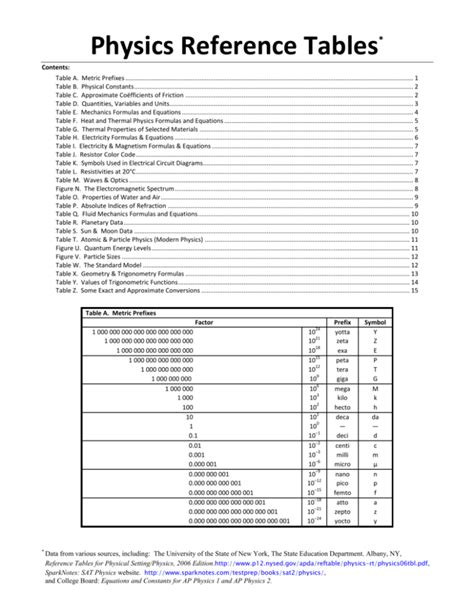In the vast and ever-expanding realm of physics, a multitude of fundamental concepts, principles, and equations serve as the building blocks upon which our understanding of the universe is constructed. For the inquisitive mind seeking to navigate this labyrinth of knowledge, a comprehensive reference table proves invaluable.

Table 1: Fundamental Constants
| Constant | Value | Units |
|---|---|---|
| Gravitational constant (G) | 6.67408 × 10^-11 | m^3 kg^-1 s^-2 |
| Speed of light in vacuum (c) | 299,792,458 | m/s |
| Planck constant (h) | 6.62606957 × 10^-34 | J s |
| Boltzmann constant (k) | 1.38064852 × 10^-23 | J/K |
| Avogadro constant (NA) | 6.02214076 × 10^23 | mol^-1 |
| Elementary charge (e) | 1.602176565 × 10^-19 | C |
Table 2: Kinematic Equations
Constant Velocity Motion:
| Equation | Description |
|---|---|
| x = x0 + vt | Displacement (x) as a function of time (t), initial position (x0), and constant velocity (v) |
| v = (x – x0) / t | Constant velocity (v) as a function of displacement (x), initial position (x0), and time (t) |
Uniformly Accelerated Motion:
| Equation | Description |
|---|---|
| x = x0 + vt + (1/2)at^2 | Displacement (x) as a function of time (t), initial position (x0), initial velocity (v), and constant acceleration (a) |
| v = v0 + at | Velocity (v) as a function of time (t), initial velocity (v0), and constant acceleration (a) |
| v^2 = v0^2 + 2a(x – x0) | Velocity (v) as a function of displacement (x), initial position (x0), initial velocity (v0), and constant acceleration (a) |
Table 3: Electromagnetic Equations
Electric Fields:
| Equation | Description |
|---|---|
| E = kq / r^2 | Electric field (E) created by a point charge (q) at a distance (r) from the charge, where k is Coulomb’s constant |
| F = Eq | Electric force (F) on a point charge (q) in an electric field (E) |
Magnetic Fields:
| Equation | Description |
|---|---|
| B = μ0I / (2πr) | Magnetic field (B) created by a current-carrying wire (I) at a distance (r) from the wire, where μ0 is the vacuum permeability |
| F = BIL | Magnetic force (F) on a current-carrying wire (I) of length (L) in a magnetic field (B) |
Electromagnetic Waves:
| Equation | Description |
|---|---|
| c = λf | Speed (c) of electromagnetic waves as a function of wavelength (λ) and frequency (f) |
| E = hf | Energy (E) of a photon as a function of Planck’s constant (h) and frequency (f) |
Table 4: Quantum Mechanics
Wave-Particle Duality:
| Equation | Description |
|---|---|
| λ = h / p | De Broglie wavelength (λ) associated with a particle of momentum (p) |
Schrödinger’s Equation:
| Equation | Description |
|---|---|
| iħ∂Ψ / ∂t = HΨ | Time-dependent Schrödinger’s equation, where Ψ is the wave function, ħ is Planck’s constant divided by 2π, i is the imaginary unit, and H is the Hamiltonian operator |
Uncertainty Principle:
| Equation | Description |
|---|---|
| Δx Δp ≥ h / (4π) | Heisenberg’s uncertainty principle, where Δx is the uncertainty in position, Δp is the uncertainty in momentum, and h is Planck’s constant |
Applications and Motivations: Exploring New Horizons
The principles and equations outlined in this reference table have led to countless groundbreaking discoveries and innovations that have shaped our modern world. From the development of lasers and transistors to the advancements in medical imaging and space exploration, physics continues to play a crucial role in driving technological progress.
Common Mistakes to Avoid:
- Confusing velocity with acceleration when analyzing motion.
- Neglecting the effects of friction in real-world applications.
- Misinterpreting the uncertainty principle as implying that quantum objects are inherently unpredictable.
Conclusion: Physics as a Tool for Understanding the World
The physics reference table presented in this article serves as a comprehensive guide to the fundamental concepts and equations governing the physical world. By delving into the depths of physics, we not only gain a deeper understanding of the universe but also unlock the potential to create new technologies and solve complex societal challenges.
